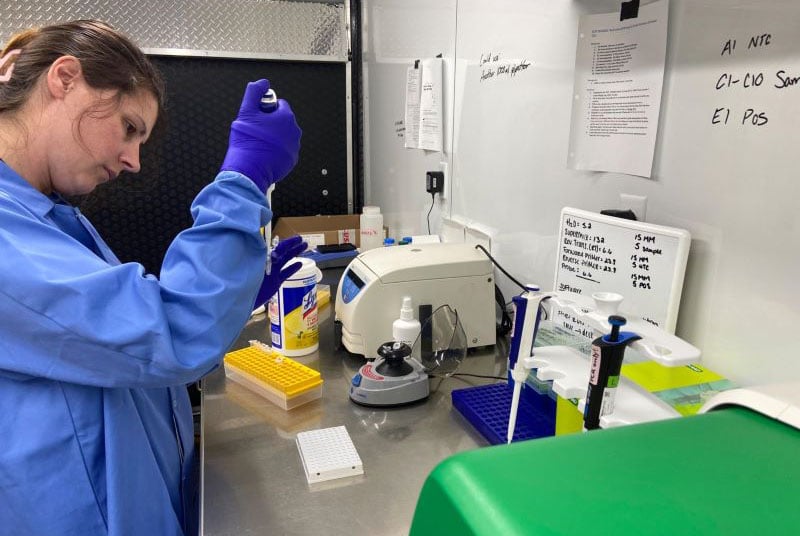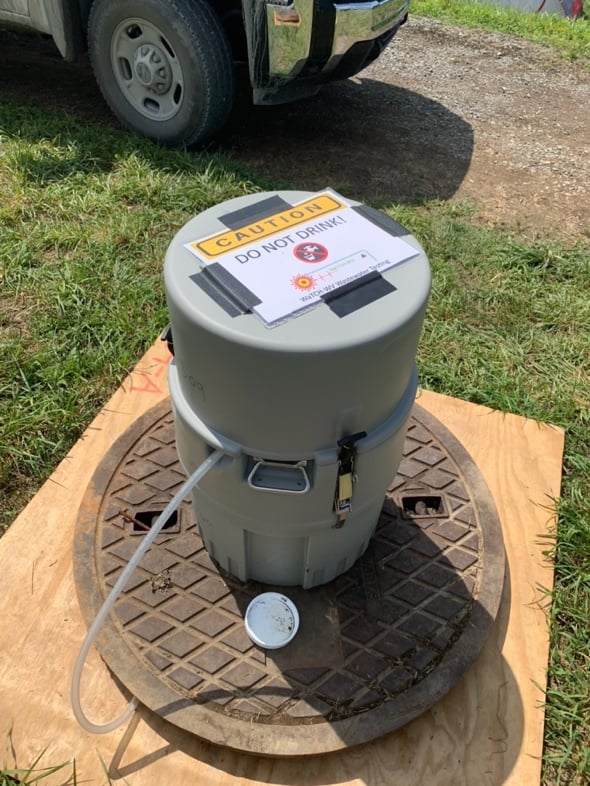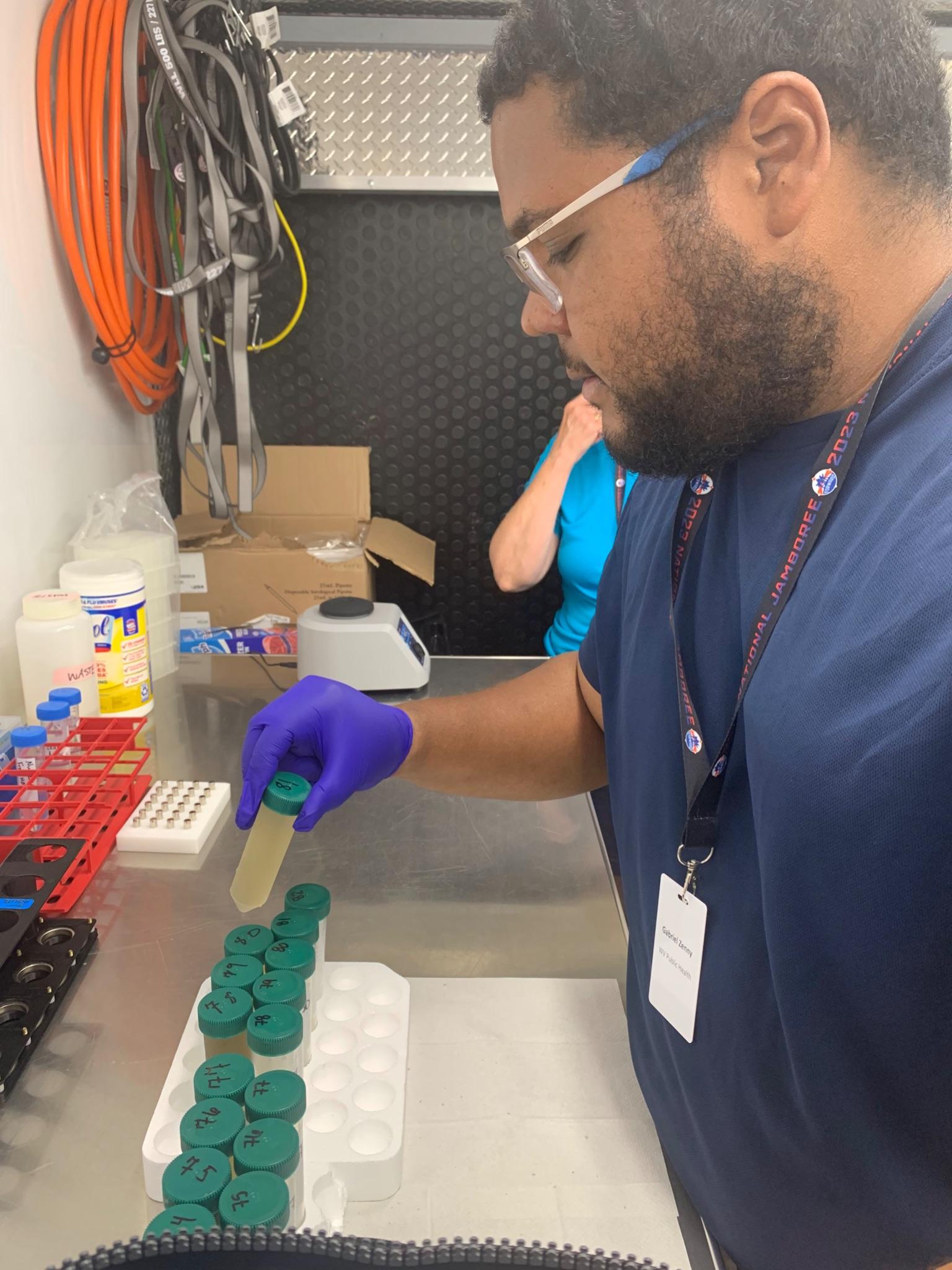
Use of Wastewater Surveillance in Multi-Day, Mass Gathering Events
Dominique Wong, MD

Taylor Koepfler, MSFS, MU Forensic Science Center, preparing a qPCR plate during the 2023 National Boy Scout Jamboree.
Multi-day mass gathering events present unique medical concerns, including the risk of infectious disease outbreaks. Mass gathering events provide entertainment and education and promote healthy social interactions. They can also, however, bring people from all parts of the world together in close proximity with significant implications for global health security. Infectious disease detection, identification and prevention, mitigation and treatment steps must be considered, so these events are not marred by participant illness, disease spread, local health system overload and outbreak dissemination to participant cities on their return.
Examples of mass gathering events with infectious disease spread abound. In 2015, the 23rd World Scout Jamboree in Japan was marred by a meningitis outbreak.1 The Hajj, one of the world’s largest multi-day mass gatherings, has similarly seen meningitis outbreaks and routinely results in outbreaks of hepatitis A, influenza and other pneumonias, and tuberculosis. 2,3
Measles outbreaks are not uncommon in mass gathering events, particularly during events attracting a younger demographic.4 Norovirus and other gastrointestinal pathogens are also frequently responsible for disease outbreaks during events.
Wastewater surveillance is a tool for population based infectious disease surveillance that has been used in the past for early disease detection such as for poliovirus. During the COVID pandemic, wastewater surveillance technology provided important information about early pathogen detection and disease trending for public health officials, and its use grew rapidly during this time. Wastewater based epidemiology (WBE) is not reliant on individual testing. Some pathogens are shed in wastewater by hosts prior to clinical disease, and wastewater surveillance has the ability to detect and trend these pathogens prior to detection by syndromic surveillance or individual test results and without regard to public appetite for individual testing. WBE is economical, providing a population view at a fraction of the cost of individual testing and can be conducted without disrupting event activities.
 WaTCH-WV Wastewater autosampler
WaTCH-WV Wastewater autosampler
WATCH-WV (Wastewater Testing for Community Health in West Virginia) is a multi-organizational collaborative involving two West Virginia universities (West Virginia University and Marshall University) as well as federal, state, local, and private entities, that has developed wastewater based, biologic pathogen surveillance capabilities throughout West Virginia during the COVID pandemic. Team members include scientists, laboratory technicians, civil engineers, public health and epidemiologists, environmental experts, statisticians, and clinical physicians. SARS-CoV2 was the WATCH-WV project’s original target; however, the project also researched wastewater surveillance capability for other targets, including MPox, influenza, respiratory syncytial virus, and norovirus.
With federal funding, a WaTCH-WV mobile wastewater surveillance lab was designed, fitted, and deployed directly to the 2023 National Scout Jamboree, a multi-day event of approximately 15,000 staff and participants from around the United States and from abroad. The team mapped the site wastewater system, determined general occupancy patterns, and rapidly and strategically placed wastewater autosamplers. An intensive, on-site PCR testing schedule was adopted, and timely and frequent (daily) results were generated by on-site lab technicians. A parallel system was in place using samples overnight-mailed to the established wastewater laboratories based at the universities. Essential to the use of wastewater surveillance is the ability to understand the data generated. The years of experience with SARS-CoV2 wastewater surveillance have highlighted what interpretations can be made from the data and equally importantly, what cannot be inferred. For this event, the results were rapidly interpreted and communicated to event health officials, allowing time for public health interventions as deemed necessary.
Wastewater surveillance is population surveillance and does not identify infected individuals. However, wastewater surveillance results could guide event public health/emergency management actions to minimize the impact a disease outbreak could have on a mass gathering event, the local community, and the home locations of participants and staff. Early detection of a pathogen of significance could guide directed individual testing. Positive surveillance test results, especially from gastrointestinal pathogens, could indicate the need for more intensified environmental, food, or water testing. Depending on the pathogen and disease characteristics, positive wastewater results could suggest that participants from discrete sewer shed areas should be separated from the general population. Event management could institute public health policies for the event, including rescheduling or minimizing large group close quarters events, maximizing air flow and ventilation, dispensing PPE, and instituting intensified cleaning protocols. Wastewater surveillance results could inform public health communications with participants on disease awareness and prevention education. Pathogen detection could trigger communications with host city public health officials to prepare them for potential outbreaks. Informing local hospitals of pathogen detection could inform local providers of potentially unexpected pathogens that would otherwise be atypical for that area.
 Gabriel Jamill Zenny organizing samples and preparing them for processing during the 2023 World Scout Jamboree
Gabriel Jamill Zenny organizing samples and preparing them for processing during the 2023 World Scout Jamboree
As medical directors or city or state emergency planners, it is our responsibility to prepare for, prevent, and mitigate the burden of infectious disease outbreaks at multi-day events. Newer technology and recent advances in wastewater surveillance allow for an effective, rapid, economical, and sustainable infectious disease surveillance program. With this tool added to the public health toolbelt, mass gathering events can continue to provide enjoyable social benefits while minimizing the negative health impact of disease outbreak.
- Kanai M, Kamiya H, Smith-Palmer A, Takahashi H, Hachisu Y, Fukusumi M, Saitoh T, Ohnishi M, Sunagawa T, Matsui T, Oishi K. Meningococcal disease outbreak related to the World Scout Jamboree in Japan, 2015. Western Pac Surveill Response J. 2017 May 8;8(2):25-30. doi: 10.5365/WPSAR.2016.7.3.007. PMID: 28729922; PMCID: PMC5516400.
- Alzeer AH. Respiratory tract infection during Hajj. Ann Thorac Med. 2009 Apr;4(2):50-3. doi: 10.4103/1817-1737.49412. PMID: 19561924; PMCID: PMC2700482.
- González-Val R, Marcén M. Mass gathering events and the spread of infectious diseases: Evidence from the early growth phase of COVID-19. Econ Hum Biol. 2022 Aug;46:101140. doi: 10.1016/j.ehb.2022.101140. Epub 2022 Apr 22. PMID: 35525103; PMCID: PMC9027297.
- Hoang V, Gautret P. Measles outbreaks at mass gathering mostly occur at youth events.The Lancet Inf Dis. 2020 Jan 20(1):23. DOI:https://doi.org/10.1016/S1473-3099(19)30685-1



